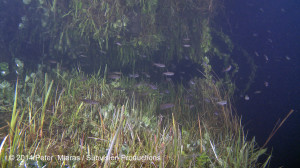Recently Subvision Production filmed wild Chinook salmon smolts, in their smolting stage. The resulting footage is now available. A time coded version is available on our Youtube channel. 
Still frame out take of another clip of wild Chinook salmon smolts
Below is a short overview of the life cycle of Pacific salmon in general. Enjoy! Pacific salmon species vary in terms of their life cycles. The most known species are Sockeye, Chinook, Coho and Chum. Some spend little time in streams, some spend years, some mature at two years other at five. Their lifespan differs too from 2 -5 years. But all of them are terminal spawners, meaning once they have spawned they die. However some, like Steelhead and Cutthroat, can spawn more than once..
All Pacific salmon are anadromous. This means they start their lifes in freshwater (streams, lakes, rivers, creeks etc.) after which they migrate to the ocean, and finally return to spawn and die in the water they were born in.
Adult salmon often travel for hundreds of miles in order too return to the waters they were born in . IF they make it back, after avoiding predators like sea lions, salmon sharks and g all kind of obstacles ( water falls, dams etc.), the males and females court, and ultimately breed. When they spawn, the male releases sperm and the female releases eggs.
The eggs and sperm float in a cloud of milky substance called “milt” and settle into a “redd” a nest the female has prepared. It is usually covered with gravel that will protect the eggs until they hatch.
The salmon that spawned die (usually days after spawning). Their bodies remain in the water or along the shore. Bears, eagles, wolf and other animals will feed on them and parts of the carcass will even serve as nutrition for trees.
The eggs:
Of the many eggs that the female has released, some will be successfully fertilized by the male’s sperm. The eggs are fragile and many eggs will be destroyed.Inside the egg is an embryo tat feeds on the yoke. When it gets big enough it will break free of the shell and become a little fish with the yoke still attached.
Alevin
Alevins’ yolk sac contains sufficient nutrition for their early development. They remain under the gravel for protection against predators until their yolk sac is fully used. It is nearly impossible to see alevin in the wild!
Fry
Once it has absorbed its yolk, the alevin becomes fry. Small and vulnerable, fry spend a lot of their time avoiding predators. They head for dark pools in protected spots (e.g., under overhanging shrubs) . After a certain time, they begin their migration toward the ocean and a that stage they are called smolts
Smolts
This is the stage at which our latest footage of wild Chinook salmon smolts was filmed. Smolts actually go through a physical change to cope with the transition from fresh to salt water. This process is known as “smolting”. One of the main changes is that they get a silvery coating over their scales to camouflage them from predators.
Adult Salmon
Once the juvenile salmon enter the ocean , it will spend many months or years in the ocean. The length of time salmon spend in saltwater depends on how old they were when they entered, their species, marine conditions, and many other factors.
When they are sexually mature they return to the waters they were once born in. Their instinct is so strong that even if they are horrendously wounded they still try to reach the spawning grounds. Many don’t make it but those who do represent the strongest and toughest of their species